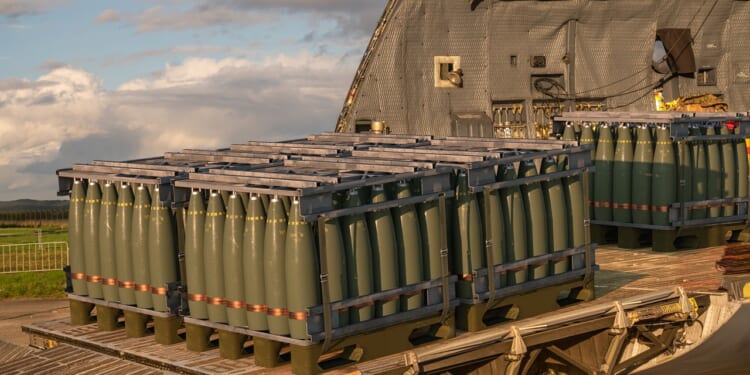American munitions today are optimized for performance—at the expense of time and scale. In preparing for a future conflict, the Department of Defense must ruthlessly correct course.
Deputy Secretary of Defense Steve Feinberg did the right thing a few weeks ago. He hauled America’s major defense contractors into a room and demanded more munitions, yesterday. That attention from such a senior official within the Pentagon is remarkable. It is also necessary, but it is far from sufficient. If the Department of Defense thinks louder directives and bigger purchase orders will fix a production model built on bespoke engineering and single-source chokepoints, it is deluding itself. The Trump Administration cannot simply change the department’s name and expect different results. On a fundamental level, it must change what it buys.
The hard truth is blunt: some of the weapons the Pentagon still tries to buy are fundamentally unmanufacturable at scale. This could mean catastrophic defeat in the next war. It needs to make preventive, rather than reactive, changes by letting go of the artifacts of an earlier industrial era and by building a new, elastic munition ecosystem.
Too many of the United States’ weapons systems have been optimized for one metric—performance—at the expense of time and scale. The result are munitions that require months of hand-assembly, exotic materials, and airplane-like certification processes for components that should roll off of production lines like commodity parts. It’s no wonder the supply chain is not responsive. If we want surge capacity that endures, we must buy weapons that can be manufactured at scale, dump the systems that cannot, and bring new firms into the game to design and build scalable munitions.
Think about cloud computing. Hundreds of billions dollars have been invested to create services that scale elastically across the globe. Need more computing power? Providers spin it up by using standardized components, modular architectures, automation, and guaranteed marketplace demand. The magic is not only money, although that plays a role: it is standardization, modularity, and economic certainty. That blueprint maps directly to munitions, too: standardize, modularize, industrialize, and create market signals that make surge production rational.
Here are three concrete reforms to get there.
First: redesign for scalable and time-bound manufacture, ruthlessly. Performance is valuable only if it is deliverable in war. Mandate design-for-manufacture (DFM) reviews for every urgent buy, and fund 60 to 90-day engineering sprints that convert “boutique” designs into producible variants. Standardize interfaces across families of rounds and missiles so guidance, fuzing, and propulsion modules are interchangeable. Replace custom fasteners, exotic finishes, and single-source subassemblies with commercially viable alternatives where battlefield effect is not compromised. Tie contract payments to manufacturability metrics: parts per hour, yield, qualification time and not nebulous delivery promises.
Second: stop saving every legacy system. If a weapon cannot be economically produced in volume, retire it. Dump the old designs that are choke points, and redirect funds toward scalable replacements. Of course, this is hard to do politically, as prime contractors and program offices will resist. But retaining unmanufacturable systems is a false economy: weapons in insufficient quantities make for brittle strategies. Declaring a class of systems obsolete would give the Pentagon the moral and budgetary license to invite fresh competition—and to seed new designs intentionally built for production lines.
Third: bring new industrial players and create elastic surge capacity. If you guarantee demand and simplify contract terms, non-traditional manufacturers from automotive suppliers, heavy machinery plants, electronics assemblers will retool to produce casings, motors, subassemblies, and more. Establish master licensing arrangements so vetted commercial firms can produce under license, create surge-guarantee contracts that underwrite retooling costs, and run an expedited supplier-qualification track during declared surges with post-surge audits. Transform the primes into integrators and systems architects, not gatekeepers of every bolt.
These reforms can be supported with three administrative fixes: (1) shift urgent buys to multi-year surge contracts that reward speed and scale; (2) stand up an expedited qualification pathway for suppliers during surges, with after-the-fact streamlined compliance audits; and (3) fund a national munitions modernization testbed where DFM changes are proven to reduce cycle time and increase yield before being fielded.
Crucially, industrializing munitions does not mean “dumbing down” lethality. The cloud computing analogy proves the point: providers run vast, secure systems using certified, interchangeable hardware modules and automated orchestration with the result of both scale and reliability. Imagine seeker modules, guidance stacks, and warhead interfaces that are certified, stockpiled, and interoperable across multiple rounds. Primes then compete on systems integration and tradeoffs, while a broad supplier base turns out the high-volume bits and pieces.
Operationally, the benefits are immediate. Throughput rises because assembly is no longer handcrafted. Fragility decreases because the supply chain is diversified across qualified vendors. And surge capability becomes repeatable — something you can stand up again and again instead of a single, exhausting sprint that collapses when attention fades.
This will be messy. It will consume political capital. It will also require honest triage: some beloved programs must go to make room for designs that can be produced at scale. But the alternative is worse: a hollowed readiness built on scarce, museum-grade systems that cannot be fielded in the quantities a high-intensity fight demands.
So the Pentagon must stop beating a dead horse by shouting louder into the conference room. It must redesign what it fields, retire what cannot be produced, and bring new companies and industrial architectures into the effort. If it can learn to treat munitions as infrastructure—modular, standardized, and backed by economic guarantees—it will get not only more rounds, but a resilient industrial base that lasts.
About the Author: John Ferrari
Maj. Gen. John G. Ferrari is a nonresident senior fellow at the American Enterprise Institute. Over his 32-year US Army career, Ferrari, who is now retired, served as the director of program analysis and evaluation, the commanding general of the White Sands Missile Range, and a deputy commander for programs at the NATO Training Mission in Afghanistan. He has an MBA in finance and strategic management from the Wharton School at the University of Pennsylvania, an MA in national resource strategy and policy from the Industrial College of the Armed Forces (now called the Eisenhower School for National Security and Resource Strategy), and a BS in computer science from the United States Military Academy at West Point.
Image: Shutterstock / Mike Mareen.

















